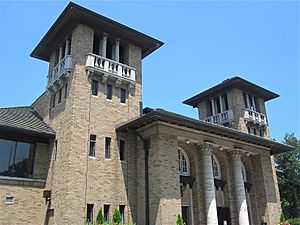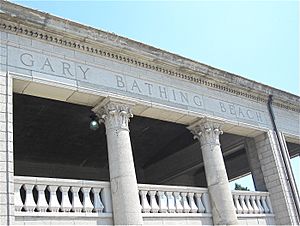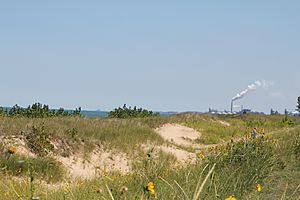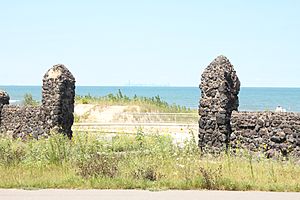Marquette Park (Gary) facts for kids
Marquette Park, first known as Lake Front Park, is a public park surrounded by Indiana Dunes National Park. It has 1.4 miles (2.2 km) of white sand beaches along Lake Michigan, along with ponds, tall sand dunes, wetlands, a lagoon, and native oak savanna. The park is located in the Miller Beach community. Miller Beach used to be its own town. However, in 1918, just before Marquette Park was created, the Town of Miller became part of Gary, Indiana. The park is also home to the Octave Chanute museum, which is a National Landmark of Soaring.
Contents
Exploring Marquette Park's Rich History
Early Inhabitants of the Dunes Waterfront
The land that is now Marquette Park has a long and interesting past. Before European settlers arrived, Miami Indians lived in this area. The southern edge of Lake Michigan, including Miller Beach, had sandy soil not good for farming. However, it was full of wildlife and fish. This made it a great place for hunting, trapping, and gathering berries.
The Miami Indians were later pushed out during the Beaver Wars in the late 1600s. After that, the Potawatomi Indians moved into the Miller Beach area from the north.
Father Marquette's Journey Through the Area
The famous explorer Father "Pere" Marquette traveled through Miller Beach. He was returning from his second trip exploring the water route from Lake Michigan to the Mississippi River. In 1673, he and Louis Jolliet had journeyed through Wisconsin and down the Mississippi. They returned to Sault Ste Marie using the Illinois and Chicago Rivers.
The next year, Marquette went down Lake Michigan to the Chicago River. He then used the portage to the Illinois River, entering the Mississippi in the spring of 1675. Marquette became very ill. As he returned that spring, he passed along the shores of Miller Beach, close to death. He died just a few days later in Michigan.
How Marquette Park Was Created
Before the Marquette Park Lagoon was built, this park area was where the Grand Calumet River flowed into Lake Michigan. An early settler named Joseph Bailly planned a town here called Indiana City. It appeared on maps for many years but never grew beyond a few small shacks.
During the time before the American Civil War, the area that became Miller Beach was an important part of the Underground Railroad. The dunes and swamp areas of Miller, now part of Marquette Park, offered a safe place for runaway slaves.
Until 1874, this sandy land was just a quiet part of the dunes. In 1874, it became part of a 200-acre (0.81 km2) sand dunes homestead owned by Robert and Druisilla Carr. During the Carr family's time, the dunes became the site of important hang gliding experiments. These were carried out in 1896-1897 by a team led by the aviation pioneer Octave Chanute.
Naming and Building the Park
Even though the Carr family owned the land for years, in 1919, United States Steel Corporation claimed it and gave it to the City of Gary for a park. This land transfer was part of a disagreement about the town of Miller being forced to join the city of Gary.
When this area was first opened to the public, it was called "Lake Front Park." However, the park was soon renamed to honor Father Marquette. A large statue of the explorer stands at the park's entrance.
In the 1920s, the city of Gary spent a lot of money improving the park. The "Marquette Park Pavilion" was built near the beach. Most of a wetland area behind the beach, which was once part of the Grand Calumet River, was dug out to create the "Marquette Lagoon." Today, two bridges inspired by Japanese design cross the lagoon.
Historic Buildings in Marquette Park
The Aquatorium: A Place to View the Water
What is now called the Gary Bathing Beach Aquatorium was designed in 1921. It was built as a shower, bathroom, and changing facility and was known as the Lakefront Park Bathhouse. For many years, it was a main gathering spot for the Miller Beach community. However, by the 1960s, the building was in bad shape. In 1971, it was closed and boarded up.
The Aquatorium was saved from being torn down by the Chanute Aquatorium Society in 1991. The Society created the word "Aquatorium," meaning "place to view the water." They wanted to give the building a new name that wasn't "bathhouse."
Today, the building is no longer a place to change or shower. It has been restored as a museum honoring Octave Chanute, who is known as the "father of flight." Chanute performed some of the first successful glider flights in human history in the tall dunes just steps from the building. His successful experiments and glider designs helped pave the way for the Wright brothers' first powered flight at Kitty Hawk. A copy of Chanute's hang glider is displayed to celebrate his work. The building also honors the Tuskegee Airmen, who were aviation pioneers and helped integrate the armed forces.
The building is also important for its architecture. It is one of the earliest examples of using pre-cast concrete blocks for construction. Ninety percent of the building is made from just six basic cast blocks. The most common one is the T-Block, which was an early version of today's standard concrete block.
Marquette Park Pavilion: A Community Hub
The "Recreation Pavilion" was built in 1923-24. It was designed by the same architects as the Aquatorium and cost $350,000. Located on the south side of the lagoon, it was renovated in 1966, the mid-1990s, and again around 2008. The building is still a popular place for many events, from weddings to community gatherings.
Marquette Park's Modern Revival
By the 1970s, Marquette Park had fallen into disrepair. Its comeback began with the restoration of the historic Aquatorium and Marquette Park Pavilion in the 1990s. In 2009, the Northwest Indiana Regional Development Authority (RDA) gave the City of Gary $28,190,000. This money was for designing and building improvements to the park. The goal was to make the park easier to access, protect its natural features, add new fun and educational areas, and restore its famous historic buildings.
In 2010, the city revealed the Marquette Park Lakefront East Master Plan. This plan outlined all the improvements. The completion of the $28 million redevelopment was celebrated by The New York Times in August 2017. The article highlighted the renovated Marquette Park Pavilion and the Gary Aquatorium/Museum of Aviation.





